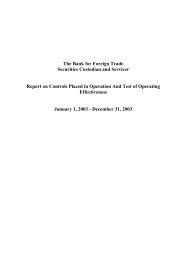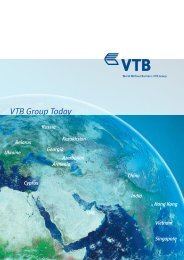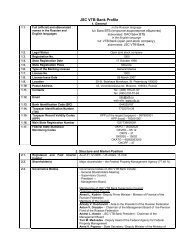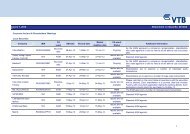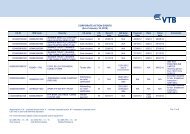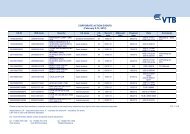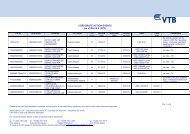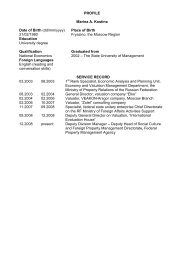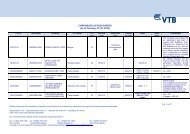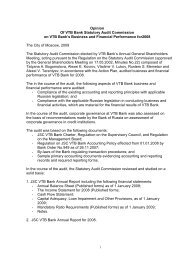Annual report 2011 - VTB
Annual report 2011 - VTB
Annual report 2011 - VTB
- No tags were found...
You also want an ePaper? Increase the reach of your titles
YUMPU automatically turns print PDFs into web optimized ePapers that Google loves.
<strong>VTB</strong> BankNotes to the Consolidated Financial Statements – 31 December <strong>2011</strong> and 2010(in billions of Russian Roubles)5. Summary of Principal Accounting Policies (continued)Allowances for impairment of financial assets (continued)For the purposes of a collective evaluation of impairment, financial assets are grouped on the basis of similar creditrisk characteristics within classification categories. Those characteristics are relevant to the estimation of future cashflows for groups of such assets by being indicative of the debtors’ ability to pay all amounts due according to thecontractual terms of the assets being evaluated.Future cash flows in a group of financial assets that are collectively evaluated for impairment are estimated on thebasis of the contractual cash flows of the assets and the experience of management in respect of the extent, to whichamounts will become overdue as a result of past loss events and the success of recovery of overdue amounts. Pastexperience is adjusted on the basis of current observable data to reflect the effects of current conditions that did notaffect past periods and to remove the effects of past conditions that do not exist currently.Impairment losses are recognized through an allowance account to reduce the asset’s carrying amount to the presentvalue of expected cash flows (which exclude future credit losses that have not been incurred) discounted at theeffective interest rate of the asset. The calculation of the present value of the estimated future cash flows of acollateralized financial asset reflects the cash flows that may result from foreclosure less costs for obtaining andselling the collateral, whether or not foreclosure is probable.If, in a subsequent period, the amount of the impairment loss decreases and the decrease can be related objectivelyto an event occurring after the impairment was recognized (such as an improvement in the debtor’s credit rating), thepreviously recognized impairment loss is reversed by adjusting the allowance account through profit or loss, to theextent that the carrying value of the asset does not exceed its amortized cost at the reversal date.Uncollectible assets are written-off against the related allowance for impairment after all the necessary procedures torecover the asset have been completed and the amount of the loss has been determined.Impairment of available-for-sale financial assetsIf an available-for-sale asset is impaired, an amount comprising the difference between its cost (net of any principalpayment and amortization) and its current fair value, less any impairment loss previously recognized in the incomestatement, is transferred from equity to the income statement. Reversals in respect of equity instruments classified asavailable-for-sale are not recognized in the income statement, but are rather retained in other comprehensive incomein a separate component of equity. Reversals of impairment losses on debt instruments are reversed through theincome statement if the increase in fair value of the instrument can be objectively related to an event occurring afterthe impairment loss was recognized in profit or loss. A significant or prolonged decline in the fair value of an equityinstrument classified as available-for-sale below its cost is also objective evidence of impairment of this instrument.Non-current assets and disposal group held for saleNon-current assets (or disposal groups, which may include both non-current and current assets and liabilities) , areclassified in the statement of financial position as ‘non-current assets held for sale’ (or as ‘assets of disposal groupheld for sale’ and ‘liabilities of disposal group held for sale’) if their carrying amount will be recovered principallythrough a sale transaction, including deconsolidation of a subsidiary holding the assets, within twelve months after theend of the <strong>report</strong>ing period. Assets (or disposal groups) are reclassified when all of the following conditions are met:(a) the assets are available for immediate sale in their present condition; (b) the Group’s management approved andinitiated an active programme to locate a buyer; (c) the assets are actively marketed for a sale at a reasonable price;(d) the sale is expected to occur within one year and (e) it is unlikely that significant changes to the plan to sell will bemade or that the plan will be withdrawn. Non-current assets or disposal groups classified as held for sale in thecurrent period’s statement of financial position are not reclassified or re-presented in the comparative statement offinancial position to reflect the classification at the end of the current period.A disposal group represent assets current and/or non-current assets to be disposed of, by sale or otherwise, togetheras a group in a single transaction, and liabilities directly associated with those assets that will also be transferred inthe transaction. Goodwill is included if the disposal group includes an operation within a cash-generating unit to whichgoodwill has been allocated on acquisition. Non-current assets are assets that include amounts expected to berecovered or collected more than twelve months after the end of the <strong>report</strong>ing period. If reclassification is required,both the current and non-current portions of an asset are reclassified.Held for sale disposal groups as a whole are measured at the lower of their carrying amount and fair value less coststo sell. Held for sale premises and equipment and intangible assets are not depreciated or amortised.Reclassified financial instruments, deferred taxes and investment properties held at fair value are not subject to thewrite down to the lower of their carrying amount and fair value less costs to sell. Reclassified financial instruments,deferred taxes and investment properties held at fair value shall be remeasured in accordance with applicable IFRSsbefore the fair value less cost to sell of the disposal group is remeasured.Liabilities directly associated with disposal groups that will be transferred in the disposal transaction are reclassifiedand presented separately in the statement of financial position.19



